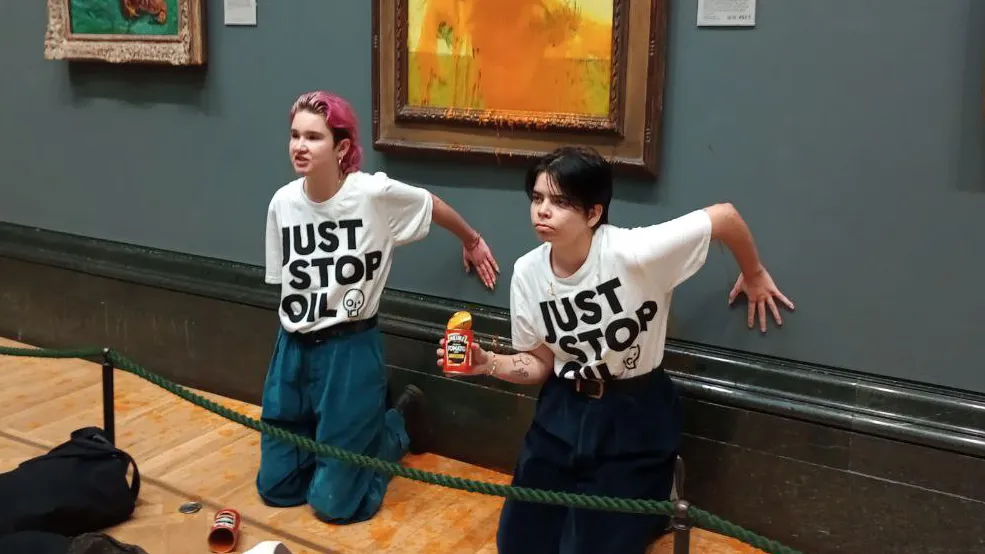“Tomato Soup thrown on Van Gogh Painting” might be a headline you’ve seen recently in your feed. Beginning in spring of this year, protestors across Europe and the US have been organizing stunts in a similar pursuit–to urge others to care about the climate crisis and to call attention to governments implementing new oil and gas infrastructure. In particular, the climate activism group Just Stop Oil (JSO) is the most notable, whose activists were responsible for hurling tomato soup on Van Gogh’s Sunflowers in London’s National Gallery, as well as blocking major streets across the city. None of JSO’s demonstrations have gained nearly the same level of attention as when they have thrown miscellaneous liquids on world-renowned paintings, or glued themselves to the frames.
Despite what news articles with vague headlines may lead one to believe, none of these actions have caused any real damage to the paintings themselves, as they are protected by glass and the glue they use is non-damaging to the frames. These demonstrations tap into the global consciousness, as anyone can recognize the masterpieces activists have chosen as a medium for their message. One might be confused why JSO and other groups are doing this or feel a degree of repulsion or shock, but by using pieces of fine art, these protesters are broadening their statement, connecting back to centuries of art history.
Artists use their unique style to depict how they view the world around them. Oftentimes, they find influence in the beauty of natural settings. Journalist Philip Kendicott notes that Van Gogh’s Sunflowers represents “ideals of natural beauty and regeneration, the very things imperiled by global warming.” Other targeted paintings include impressionist artist Claude Monet’s Grainstacks, found in Museum Barberini in Potsdam, Germany, which was hit with a slew of mashed potatoes from the German equivalent of JSO, Letze Generation.
During the mid-19th century Impressionism Movement, artists explored the depiction of natural settings in a modernized way as industrialization was beginning to take shape. Impressionist artists depicted how the natural world was changing, and wanted to highlight negative aspects while remembering natural beauty that would soon be overrun. Quick, fluffy strokes give the movement a distinct style that mirrored the fast-paced modern life associated with industrialization and its infiltration of nature. Climate activists didn’t choose the paintings for their demonstrations at random; by evaluating the original context of these works, protestors recognize what these paintings represent and are directly opposing the change that has led society on a path to destroy the future.
Civil protests and disruptions in places that naturally draw large crowds can also be viewed as performance art. Throughout the years, some artists have chosen to put themselves on display rather than using a canvas to spread their messages. Marina Abramović is a revered performance artist who has dedicated her life to dissolving the boundary between viewer and performer, or art itself. For her exhibit at the New York Museum of Modern Art in 2010, The Artist is Present, Abramović spent 3 months sitting motionless and silent in a chair for 8 hours a day, inviting visitors to take a seat across from her. Abramović challenges the viewer to transform from a passive onlooker to becoming completely immersed in her work. Artistic concepts like these can also be applied to climate demonstrations.
When climate protestors vandalize paintings, they attempt to mobilize the world to take action against the imminent peril of climate change. Rob Greenfield is another environmental activist who has engaged in performance art. In 2016, Greenfield spent thirty days consuming like the “average American” and wearing his trash in a suit on his body while walking around New York City to highlight waste created by the culture of rampant consumerism. By differentiating themselves from the ordinary hustle and bustle of everyday life, performance artists and activists alike are able to grab the public’s attention and bring into question their established routines and preconceptions. Shock value is a major theme in this style of work; it is necessary to break through the ordinary. Breaking down the established norms through live visual performances provides an opportunity for audiences to reconsider the state of the world.
While glued to the frame of Van Gogh’s Sunflowers, JSO climate activist Phoebe Plummer posed a question to onlookers: “Are you more concerned about the protection of a painting, or the protection of our planet and people?” Though her sentiment was not reflected in headlines of news articles trying to create buzz, she makes an important point. Art has always been at the forefront of culture, challenging existing dynamics. However, the climate emergency has the potential to destroy the world as we know it, making art and its purpose absolutely meaningless. To climate activists around the world, it does not make sense to protect an imitation of life rather than life itself.
Sources
Greenfield, Robert. “Trash Me .” Rob Greenfield – Activist and Humanitarian, 16 Nov. 2022, https://www.robgreenfield.org/trashme/.
Kennicott, Philip. “When Activists Attacked Van Gogh’s ‘Sunflowers,’ They Affirmed Its Power.” The Washington Post, WP Company, 15 Oct. 2022, https://www.washingtonpost.com/arts-entertainment/2022/10/14/van-gogh-sunflowers-soup-clim ate/.
Just Stop Oil. “Just Stop Oil.” Just Stop Oil – No More Oil and Gas, 30 Nov. 2022, https://juststopoil.org/.
Saner, Emine. “Marina Abramović: ‘I’m an Artist, Not a Satanist!’.” The Guardian, Guardian News and Media, 7 Oct. 2020, https://www.theguardian.com/artanddesign/2020/oct/07/marina-abramovic-im-an-artist-not-a-sat anist.
Sharp, Sarah Rose. “Climate Activists Give Monet’s ‘Grainstacks’ a Mashed Potato Facial .” Hyperallergic, 24 Oct. 2022, https://hyperallergic.com/772934/climate-activists-monet-grainstacks-mashed-potato-facial/.

